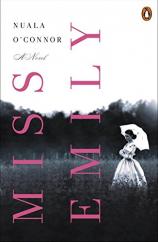Miss Emily
Review
Miss Emily
MISS EMILY, the newest novel from Irish writer Nuala O’Connor, has the ability to capture the attentions of readers of historical fiction, biography and poetry alike. How can it do this? The answer is deceivingly simple. The book is, first and foremost, the story of two 19th-century women and the surprising way their lives intersect. The first woman is a fictional Irish immigrant, fresh off the boat from her homeland, stepping for the first time on the cobblestone streets of a bustling New England. The second, however, is the very real, very human figure of the enigmatic poet Emily Dickinson, long before her status was cemented as one of the most prolific and innovative American poets to ever live.
While a novel about a poet might turn away people who aren’t interested in poetry or don’t have any knowledge of Dickinson besides what they learned in high school, I should mention right off the bat that MISS EMILY isn’t designed only for a select audience of elite literary scholars, and you don’t need any kind of poetic education to read and enjoy it. The novel is character- and style-driven at its core, and whether or not you have the entirety of Dickinson’s works memorized --- em dash and all --- or took Poetry 101 in college and haven’t looked back since, O’Connor’s masterful storytelling and attention to historical and literary details, as well as her astuteness of human emotion, will pique the interest of a multitude of different sorts of readers.
"The historicity of the story...while integral to understanding the context of the time, is less significant than the confidence with which O’Connor adopts and makes believable Dickinson’s words, crafting every turn of phrase just so until O’Connor as author disappears, and her voice, almost magically, is replaced by that of the long-dead poet. "
Even those who don’t know anything about literature will admit that there is an undeniable air of mystery that surrounds the lives of well-known writers of the past, intriguing both modern readers and wordsmiths alike. Despite the daunting task of writing a novel not only about the poet but that is written partially in her own point of view, O’Connor beautifully reanimates the character of Emily Dickinson, both Person and Poet.
The actual plot of MISS EMILY is straightforward enough. A young Irish woman named Ada Concannon, tired of her life in Ireland and lured by the idea of starting over in a foreign land, hops a boat destined for Amherst, Massachusetts. There she soon begins work for the Dickinson family, home to Emily Dickinson, spinster and writer who lives, despite her age, at the home of her parents, preferring to leave as little as possible. The two form an odd sort of friendship, and the story continues from there.
As for the structure, the novel is broken up into short, practically bite-sized chapters. Each written in first person point of view and present tense, they switch back and forth between the voices of Ada and Emily. Although these chapters, some of which are only a couple of pages long, work to make sure moments don’t linger for too long, I found that they were more tedious than entertaining, particularly during the opening portion of the novel, which is mainly expository. Switching back and forth so quickly, in fact, made me long more than once for the pace to slow down a little to give everything time to soak in. As the narrative picked up speed, however, the chapters became longer, which worked to alleviate the issue.
What makes MISS EMILY truly stand out is O’Connor’s meticulous prose. Every paragraph and sentence, down to each individual word, is purposefully and artfully positioned within the text as a whole. This is particularly important considering the subject matter of the novel: poetry or, in other words, literary self-control, a commitment to subtlety. Oftentimes O’Connor’s prose veers toward the poetic, mostly and unsurprisingly in the sections narrated by Emily, but it is done with such care that the narrative meaning, instead of being lost in the lofty syntax and language, is emphasized. Despite the clarity and readability of the prose, there were several times when I had to turn to my dictionary when it came to O’Connor’s commitment to 19th-century vocabulary.
In reading MISS EMILY, it is abundantly clear that O’Connor has done her research, and then some, when it comes to the life of Emily Dickinson and her poetry, the ins and outs of 19th-century New England, and the history and traditions of 19th-century Ireland brought to America by Irish immigrants. The historicity of the story, however, while integral to understanding the context of the time, is less significant than the confidence with which O’Connor adopts and makes believable Dickinson’s words, crafting every turn of phrase just so until O’Connor as author disappears, and her voice, almost magically, is replaced by that of the long-dead poet. For that reason alone, although there are countless others, MISS EMILY deserves to be read at least once, but probably twice.
Reviewed by Gena LeBlanc on July 17, 2015
Miss Emily
- Publication Date: July 14, 2015
- Genres: Fiction, Historical Fiction
- Paperback: 256 pages
- Publisher: Penguin Books
- ISBN-10: 014312675X
- ISBN-13: 9780143126751





